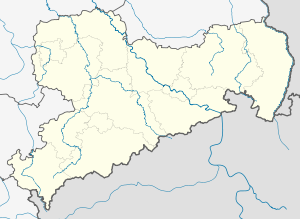Moat bridge
Coordinates: 51 ° 3 ′ 9 ″ N , 13 ° 43 ′ 58 ″ E
| Moat bridge | ||
|---|---|---|
| The moat bridge with long gallery and crown gate | ||
| Convicted | Kennel ditch | |
| place | Dresden | |
| overall length | 32 meters | |
| width | 5.50 meters | |
| completion | 1718, 1770, 1780, 1930, 1951 | |
| location | ||
|
|
||
From 1718 the original moat bridge connected the western Dresden suburbs (today's Wilsdruffer Vorstadt ) outside the Dresden fortifications with the Zwinger that was built in 1709 . The name Zwinger goes back to the name customary in the Middle Ages for a part of the fortress between the outer and inner fortress walls, although the Zwinger no longer fulfilled a function corresponding to its name when construction began. The bridge led over the city moat (Zwingergraben) in front of the outer fortress wall.
history
The moat bridge was a small connection from Ostra-Allee over the water-filled moat to the Zwinger's crown gate, which was completed in 1714 . Alongside the Wall Pavilion, this is the most famous part today and is often the symbol of the Zwinger in pictures. The Kronentor originally allowed access from outside the city through the fortress wall. The court architect Matthäus Daniel Pöppelmann planned a matching stone bridge over the moat in front of the ramparts. But the minister responsible for construction, August Christoph von Wackerbarth , asked for a narrow wooden footbridge that could have been quickly dismantled in the event of an attack. He was able to assert himself with it, especially since there was no city gate at this point that could have been locked. Even Pöppelmann's compromise proposal to build only a small part of the bridge out of wood failed. The wooden bridge was completed in 1718 and served as a small secret exit for court carriages when they wanted to go to the country. She was guarded by specially posted guards from the Taschenbergpalais .
In fact, a good 40 years later, the bridge was demolished for defense purposes. In the Seven Years' War the Prussian Army stood in front of Dresden in 1759/60 and occupied the city. Seven years after the end of the war, the bridge was rebuilt in 1770. This happened in such poor quality that it had to be dismantled as early as 1780 and rebuilt again.
The bridge was dilapidated again in 1804. The court received offers for a new building made of wood, iron or stone. However, that was no longer necessary. At the beginning of the 19th century, the Dresden fortifications neither corresponded to the then current defense technology nor to the size of the city. Until the 1820s, the moats at the Zwinger that were no longer needed were filled in and the bridge demolished. As a result, there was no bridge at this point for over 100 years.
During the great restoration of the Zwinger in the 1920s, Hubert Georg Ermisch planned to re-open the moat and to rebuild the bridge. With the Zwingergraben he wanted to decouple the vibrations caused by the traffic on Ostra-Allee from the Zwinger. The moat was only partially dug again and connected to the Zwingerteich . Construction of the bridge began in 1929 and was completed in June 1930. Due to the neighboring road, the bridge was shortened a little. This bridge did not last long either: it was largely destroyed during the air raids on Dresden in 1945. Only the foundations and the bridgehead on Ostra-Allee were preserved.
The bridge was rebuilt again and opened in June 1951. It had to be repaired several times in the 1970s and 1980s. This post-war bridge had to be reinforced with steel piers in 1996/97. A renewal of the bridge is planned for the 2020s.
gallery
View around 1750 from Canaletto : The Zwingergraben in Dresden (detail)
literature
- Fritz Löffler : The Zwinger in Dresden , chapter: The Kronentor with the moat bridge and the long galleries , page 29ff. VEB EA Seemann Verlag Leipzig, 1976.
Web links
Individual evidence
- ^ Peter Hilbert: New Zwinger Bridge under the Kronentor. In: sächsische.de . June 17, 2019, accessed April 15, 2020 .
- ↑ Peter Hilbert: New bridge to the Zwinger planned. In: sächsische.de. February 16, 2020, accessed April 15, 2020 .








